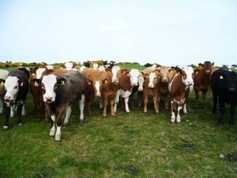A cabinet reshuffle took place in our yard at the weekend. With weaning finally complete, the winter formations were finalised. Weaned heifers were grouped for ease of feeding. Likewise, the bulls were moved for the final time. Their concentrate allowance continues to increase weekly with a view to a finish around about 15 months.
Though it was a small one, the stress of the move and the clammy weather that briefly followed hit a couple of the weanlings, whose temperatures climbed slightly. They were injected and let out to a neighbouring paddock as a precaution. Thankfully they seem to be fine, though a close eye will be kept on them.
The pregnant ladies were split into two groups. Replacement heifers and thin cows were penned together for preferential treatment, though there’ll be no meals involved. They’ll receive extra silage for as long as is deemed fit.
Bales
We feed big bale silage to all of our stock. All of our grass is preserved in this way. For over a decade the same local contractor, a friend of the family’s, has made them for us. Silage quality is one of the core principles of the farm. When good, it reduces the need for outlandish levels of concentrate supplementation to both growing and finishing stock.
Like everything, bales have their downsides. Many of you will say mould but extra layers of plastic and an insistence on glorious sunshine at harvest means we experience very few of the ugly white spots.
For us, the main negative is the leftover plastic. We’ve learned to be careful with it. I’ve seen first-hand the amount of wrap that can be salvaged from digestive tracts post slaughter. You’re talking bin-fulls of the stuff building up daily. Though unlikely to be detrimental to an animal’s performance at reasonable levels, constant ingestion of plastic is sure to cause some ill-effects. Think of the poor factories having to dispose of it too.
Removing left over plastic
In order to avoid any plastic mixing with the forage, we firstly cut away both faces of the wrap (picture 1 and 2). Then a slit is made across the round edge and the remaining plastic is removed (picture 3). The net then unravelled in a similar fashion (picture 4). Problems may (and will) occur with this method if the bale is wet.
When removing the net, if you’re not quick enough the bale will collapse onto it. If a bale is obviously a damp one, this can be avoided by simply tipping it onto its face once and doing something similar to the above. When all is done, the wrap can be rolled up neatly. There are five bales worth of plastic rolled up into one in picture 5. We stockpile our spent wrap and it’s collected annually.






 This is a subscriber-only article
This is a subscriber-only article















SHARING OPTIONS: